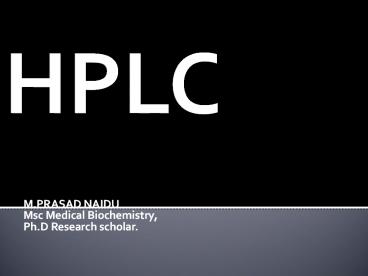HPLC. - PowerPoint PPT Presentation
Title:
HPLC.
Description:
BIOCHEMISTRY – PowerPoint PPT presentation
Number of Views:868
Title: HPLC.
1
HPLC
- M.PRASAD NAIDU
- Msc Medical Biochemistry,
- Ph.D Research scholar.
2
Instrumental requirements
- Pumps solvent delivery system
- Mixing unit, gradient controller solvent
degassing - Injector manual or auto injectors
- Guard column
- Analytical columns
- Detectors
- Recorders integrators
3
PUMP solvent delivery system
- Solvents or mobile phases must be passed via
column _at_ high pressure (1000 3000psi) - b/cos the particle size of stationary phase is
few µ (5-10 µ) - Diff types of pumps available
- Mechanical pumps operate with constant flow rate
uses sapphire piston - This type of pump is used in analytical scale
- Pneumatic pumps operate with constant pressure
use highly compressed gas - The solvents used must be of high purity
preferably HPLC grade filtered through 0.45 µ
filter - Check valves to control the flow rate of solvent
back pressure - Pulse dampeners to dampen ( make slightly wet)
the pulses
4
Mixing unit, gradient controller and solvent
degassing
- 2 types of mixing units
- Low pressure mixing chamber which uses He for
degassing solvents - High pressure mixing chamber does not require He
for degassing solvents - Mixing of solvents is done either by
- Static mixer packed with beads
- Dynamic mixer uses a magnetic stirrer
operates under high pressure
5
Gradient controller
- In an isocratic separation, mobile phase is of
same polarity throughout the process - In gradient elution tech, the polarity of the
solvent is gradually increased hence the
solvent composition has to be changed. - Hence a gradient controller is used when two or
more solvent pumps are used for such separations
6
Solvent degassing
- Several gases are soluble in org solvents
- When solvents are pumped under high pressure, gas
bubbles are formed interfere the separation
process - 3 methods
- 1. Vacuum filtration which can remove the air
bubbles. But is not always reliable complete - 2. He purging by passing He through the solvent.
Very effective but He is expensive - 3. Ultrasonication by using ultrasonicator,
which converts ultra high frequency to mechanical
vibrations this causes the removal of air
bubbles
7
Injector manual or auto injectors
- 1. Septum injectors injecting through a rubber
septum. Not common has to withstand high
pressure - 2. Stop flow (online) in which the flow of
mobile phase is stopped for a while the sample
is injected through a valve device - 3. Rheodyne injector ( loop valve type) the most
popular injector. - This has a fixed volume loop like 20 µl or 50 µl
or more - Injector has 2 modes
- 1. load position when sample is loaded in the
loop - 2. Inject mode when the sample is injected
8
Guard column
- It has a very small quantity of adsorbent
improves the life of the analytical column - Also acts a a prefilter to remove particulate
matter, if any other material - GC has the same material as that of analytical
column - GC does not contribute to any separation
9
Analytical columns
- The most imp part of the HPLC tech which decides
the efficiency of separation - Column material Stainless steel ( mostly used),
glass, polyethylene and PEEK (poly ethylene ether
ketone) (latest) - Column length 5 cm to 30cm
- Column diameter 2mm to 50 mm
- Particle size 1 µ to 20 µ
- Particle nature spherical, uniform , porous
materials are used - Surface area I gm of stationary phase provides
surface area ranging from 100-860 sq.m ( an aveg
of 400sq.m)
10
Functional group
- The functional group present in stationary phase
depends on the type of chromatographic separation - In normal phase mode contains silanol groups (
hydroxy group) - In reverse phase mode
- C18 Octa Decyl Silane (ODS) column
- C8 Octyl column
- C4 Butyl column
- CN Nitrile column
- NH2 Amino column
11
Detectors
- 1. UV- detector used based upon the light
absorption characteristics of the sample - 2 types of this detector are available
- a) fixed wavelength detector which operates at
254 nm where most drug compounds absorb - b) variable wavelength detector which can be
operated from 190nm to 600nm - 2. Refractive index detector non-specific or
universal detector not much used- low
sensitivity and specificity - 3. Flourimetric detector more specificity
sensitivity - Demerit some compounds are not fluorescent
- 4. Conductivity detector
- 5. Amperometric detector
- 6. Photodiode array detector( PDA detector)
12
Recorders integrators
- Recorders are used to record the responses
obtained from detectors after amplification - They record the baseline all the peaks obtained
with respect to time (Rt) - But the area of the individual peaks cannot be
known - Integrators improved version of recorders with
data processing capabilities - Rt, height and width of peaks, peak area, area
- Integrators provide more information on peaks
than recorders
13
Applications of HPLC
- Qualitative analysis
- Checking the purity of a compound
- Presence of impurities
- Quantitative analysis
- Multicomponent analysis or determination of
mixture of drugs - Isolation identification of drugs
- Isolation and identification of mixture of
compounds - Biopharmaceutical pharmacokinetic studies
- Stability studies
- Purification of compounds
- Environmental applications
- Forensic applications
- Biochemical separations
- Biotech, food analysis
14
THANK YOU































